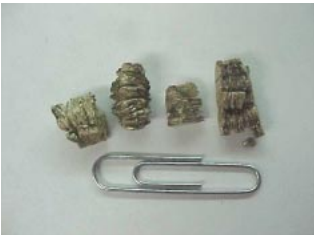WHAT IS VERMICULITE
|
Vermiculite is a type of naturally occurring mineral composed of stacks of silicon based sheets that expand into accordion-like 'books' or worm-like strands when heat is applied through a process called exfoliation. These 'books' are composed of single ply sheets. Vermiculite was discovered in the Rainy Creek Mining District of Lincoln County, Montana, in 1916 The Zonolite Company and began commercial production of vermiculite in 1921.
|
DOES VERMICULITE CONTAIN ASBESTOS?
The majority of all vermiculite insulation produced before 1990 used contaminated vermiculite from Libby. Asbestos fibers in vermiculite are too small to be seen by the naked eye. Only a trained technician using a microscope can see asbestos fibers. However, due to limitations in the methods even trained technicians cannot always determine if all vermiculite contains asbestos. Therefore, to be safe, you should assume that vermiculite insulation may be contaminated with asbestos.
WHO MINED VERMICULITE?
In the US, vermiculite was predominantly mined in Libby, Montana, from the 1920s until the mine closed in 1990 by WR Grace. While in operation, the mine in Libby produced most of the world’s supply of vermiculite. Vermiculite has been used in building insulation, potting soil and fertilizer. Unfortunately, the vermiculite from the Libby mine contained a type of naturally-occurring asbestos called tremolite-actinolite. W.R. Grace purchased the mining operations in 1963. They greatly increased production of vermiculite which resulted in increased utilization of vermiculite in many forms of commercial products with one of the most popular being Zonolite insulation.
There were other vermiculite mines in the US, however up to 90% of the vermiculite in the US and Canada came from Libby Montana.
There were other vermiculite mines in the US, however up to 90% of the vermiculite in the US and Canada came from Libby Montana.
WHAT IS THE LIBBY AMPHIBOLE?
Asbestos is a general term used to describe several different types of fibers. In efforts to point out that our fiber is unique, many people originally used the word tremolite. This is probably not the best term either, as there is actually very little tremolite in our fiber. Therefore, the best term is Libby amphibole asbestos.
The mineralogy of Libby amphibole asbestos is very unique both chemically and structurally and the chemical composition Libby amphibole transitions between winchite, richterite, and tremolite, while also containing trace amounts of actinolite and ferro-edenite.
The mineralogy of Libby amphibole asbestos is very unique both chemically and structurally and the chemical composition Libby amphibole transitions between winchite, richterite, and tremolite, while also containing trace amounts of actinolite and ferro-edenite.
WERE ALL VERMICULITE MINES CONTAMINATED WITH ASBESTOS?
No. Vermiculite is a naturally occurring mineral mined in the United States, Brazil, Argentina, Mexico, South Africa, Zimbabwe, Kenya, Uganda, Egypt, India, Russia, China, Japan and Australia. Vermiculite has a flaky, mica-like structure that is flat and shiny in its natural state and puffed and dull when expanded.
IS THERE VERMICULITE IN MY HOUSE?
Vermiculite was widely used as loose fill insulation especially in attics in domestic residences from the early 1940’s onwards. However, over the last two to three decades its use in domestic housing has declined and has usually been replaced by manmade mineral fibres such as rock wool and glass fibre (fiberglass).
Vermiculite is widely used as a beneficial additive in commercial greenhouse potting soils and in the cultivation of seedlings. It is found in many good quality packaged consumer “composts” and potting mixes available from garden centres and horticultural supply outlets.
Vermiculite is often used in passive fire protection products in high-rise construction projects to increase the fire safety of the building by preventing the premature collapse of a building, which has caught on fire; allowing for a safe evacuation and saving lives.
Vermiculite is widely used as a beneficial additive in commercial greenhouse potting soils and in the cultivation of seedlings. It is found in many good quality packaged consumer “composts” and potting mixes available from garden centres and horticultural supply outlets.
Vermiculite is often used in passive fire protection products in high-rise construction projects to increase the fire safety of the building by preventing the premature collapse of a building, which has caught on fire; allowing for a safe evacuation and saving lives.
